Interface Sampling and Indicator Minerals for Detecting the Footprint of the Lancefield North Gold Deposit under the Permian Glacial Cover in Western Australia
Abstract
:1. Introduction
2. Geological Setting
3. Materials and Methods
4. Results
4.1. Stratigraphy and Landscape of the Permian Cover
4.2. Petrography and Mineralogy of the Permian Cover
4.3. Mineralogy and Geochemistry of the Ore Zone
4.4. Heavy Minerals in the Permian Cover
4.5. Whole-Rock Geochemistry of the Permian Cover
4.5.1. Vertical Variations
4.5.2. Interface and Redox Zone Geochemistry
5. Discussion
5.1. Glacial Landscape Evolution
5.2. Chemical and Mineralogical Evolution through the Permian Cover
5.3. Interface Sampling and Indicator Minerals
6. Conclusions and Implications for Exploration
Supplementary Materials
Author Contributions
Funding
Acknowledgments
Conflicts of Interest
References
- Reid, N.; Hill, S.M.; Lewis, D.M. Spinifex biogeochemical expressions of buried gold mineralisation: The great mineral exploration penetrator of transported regolith. Appl. Geochem. 2008, 23, 76–84. [Google Scholar] [CrossRef]
- Petts, A.E.; Hill, S.M.; Worrall, L. Termite species variations and their importance for termitaria biogeochemistry: Towards a robust media approach for mineral exploration. Geochem. Explor. Environ. Anal. 2009, 9, 257–266. [Google Scholar] [CrossRef]
- Stewart, A.D.; Anand, R.R.; Balkau, J. Source of anomalous gold concentrations in termite nests, Moolart Well, Western Australia: Implications for exploration. Geochem. Explor. Environ. Anal. 2012, 12, 327–337. [Google Scholar] [CrossRef]
- Salama, W.; Gazley, M.; Bonnett, L. Geochemical exploration for supergene copper oxide deposits, Mount Isa Inlier, NW Queensland, Australia. J. Geochem. Explor. 2016, 168, 72–102. [Google Scholar] [CrossRef]
- Noble, R.R.P.; Anand, R.R.; Gray, D.; Cleverley, J. Metal migration at the DeGrussa Cu-Au sulphide deposit, Western Australia. Geochem. Explor. Environ. Anal. 2017, 17, 124–142. [Google Scholar] [CrossRef]
- Anand, R.R.; Salama, W. Gold dispersion in transported cover sequences especially in chemical (palaeoredox front) and physical (unconformity) interfaces linked to the landscape history of Western Australia. Explore Newslet. Assoc. Appl. Geochem. 2019, 183, 1–40. [Google Scholar]
- Salama, W.; Anand, R.R.; Schoneveld, L.; Noble, R.; Rogers, J. Significance of ferruginous pisoliths and interface sampling for gold exploration in the covered terrains. J. Geochem. Explor. 2021, 106794. [Google Scholar] [CrossRef]
- McMartin, I.; McClenaghan, M.B. Till geochemistry and sampling techniques in glaciated shield terrain: A review. In Drift Exploration in Glaciated Terrains; Geological Society Special Publications; McClenaghan, M.B., Bobrowsky, P.T., Hall, G.E.M., Cook, S.J., Eds.; Geological Society: London, UK, 2001; Volume 185, pp. 19–43. [Google Scholar]
- McClenaghan, M.B. Indicator mineral methods in mineral exploration. Geochem. Explor. Environ. Anal. 2005, 5, 233–245. [Google Scholar] [CrossRef] [Green Version]
- Sarala, P.; Pulkkinen, E.; Juhani Ojala, V.; Peltoniemi-Taivalkoski, A. Gold exploration using till at Petäjälehto, northern Finland. Geochem. Explor. Environ. Anal. 2009, 9, 247–255. [Google Scholar] [CrossRef]
- Salama, W.; Anand, R.R.; Verrall, M. Mineral exploration and basement mapping in areas of deep transported cover using indicator heavy minerals and paleoredox fronts, Yilgarn Craton, Western Australia. Ore Geol. Rev. 2016, 72, 485–509. [Google Scholar] [CrossRef]
- Friedrich, G.; Marker, A.; Kanig, M. Heavy mineral surveys in exploration of lateritic terrain. In Handbook of Exploration Geochemistry; Regolith Exploration Geochemistry in Tropical and Subtropical Terrains; Butt, C.R.M., Zeegers, H., Eds.; Elsevier: Amsterdam, The Netherlands, 1992; Volume 4, pp. 483–498. [Google Scholar]
- McClenaghan, M.B. Overview of common processing methods for recovery of indicator minerals from sediment and bedrock in mineral exploration. Geochem. Explor. Environ. Anal. 2011, 11, 265–278. [Google Scholar] [CrossRef]
- McClenaghan, M.B.; Parkhill, M.A.; Pronk, A.G.; Sinclair, W.D. Indicator mineral and till geochemical signatures of the Mount Pleasant W-Mo-Bi and Sn-Zn-In deposits, New Brunswick, Canada. J. Geochem. Explor. 2017, 72, 151–166. [Google Scholar] [CrossRef] [Green Version]
- Shilts, W.W. Till geochemistry in Finland and Canada. J. Geochem. Explor. 1984, 21, 95–117. [Google Scholar] [CrossRef]
- Hirvas, H. Application of glacial geological studies in prospecting in Finland. In Drift Prospecting; Paper 89-20; DiLabio, R.N.W., Coker, W.B., Eds.; Geological Survey of Canada: Ottawa, ON, Canada, 1989; pp. 1–12. [Google Scholar]
- Klassen, R.A. Glacial history and ice flow dynamics applied to drift prospecting and geochemical exploration. In Proceedings of the Exploration 97 (14–18 September 1997): Fourth Decennial International Conference on Mineral Exploration; Gubins, A.G., Ed.; Prospectors and Developers Association of Canada: Toronto, ON, Canada, 1997; pp. 221–232. [Google Scholar]
- McClenaghan, M.B.; Thorleifson, L.H.; DiLabio, R.N.W. Till geochemical and indicator mineral methods in mineral exploration. Ore. Geol. Rev. 2000, 16, 145–166. [Google Scholar] [CrossRef]
- McClenaghan, M.B.; Plouffe, A.; McMartin, I.; Campbell, J.E.; Spirito, W.A.; Paulen, R.C.; Garrett, R.G.; Hall, G.E.M. Till sampling and geochemical analytical protocols of the Geological Survey of Canada. Geochem. Explor. Environ. Anal. 2013, 13, 285–301. [Google Scholar] [CrossRef]
- Lougheed, H.D.; McClenaghan, M.B.; Layton-Matthews, D.; Leybourne, M.I.; Dobosz, A.N. Automated indicator mineral analysis of fine-grained till associated with the Sisson W-Mo deposit, New Brunswick, Canada. Minerals 2021, 11, 103. [Google Scholar] [CrossRef]
- Lehtonen, M.L.; Marmo, J.S.; Nissinen, A.J.; Johanson, B.S.; Pakkanen, L.K. Glacial dispersal studies using indicator minerals and till geochemistry around two eastern Finland kimberlites. J. Geochem. Explor. 2005, 87, 19–43. [Google Scholar] [CrossRef]
- McClenaghan, M.B.; Kjarsgaard, B.A. Indicator mineral and geochemical methods for diamond exploration in glaciated terrain in Canada. In Drift Exploration in Glaciated Terrains; Geological Society Special Publications; McClenaghan, M.B., Bobrowsky, P.T., Hall, G.E.M., Cook, S.J., Eds.; Geological Society: London, UK, 2001; Volume 185, pp. 83–123. [Google Scholar]
- Kjarsgaard, I.M.; McClenaghan, M.B.; Kjarsgaard, B.A.; Heaman, L.M. Indicator mineralogy of kimberlite boulders from eskers in the Kirkland Lake and Lake Timiskaming areas, Ontario, Canada. Lithos 2004, 77, 705–731. [Google Scholar] [CrossRef]
- Anand, R.R.; Paine, M. Regolith geology of the Yilgarn Craton, Western Australia: Implications for exploration. Aust. J. Earth Sci. 2002, 49, 3–162. [Google Scholar] [CrossRef]
- Anand, R.R.; Butt, C.R.M. A guide for mineral exploration through the regolith in the Yilgarn Craton, Western Australia. Aust. J. Earth Sci. 2010, 57, 1015–1114. [Google Scholar] [CrossRef]
- Averill, S.A. Viable indicator minerals in surficial sediments for two major base metal deposit types: Ni–Cu-PGE and porphyry Cu. Geochem. Explor. Environ. Anal. 2001, 11, 279–292. [Google Scholar] [CrossRef]
- Sarala, P.; Peuraniemi, V. Exploration using till geochemistry and heavy minerals in the ribbed moraine area of southern Finnish Lapland. Geochem. Explor. Environ. Anal. 2007, 7, 195–205. [Google Scholar] [CrossRef]
- Eppinger, R.G.; Fey, D.L.; Giles, S.A.; Grunsky, E.C.; Kelley, K.D.; Minsley, B.J.; Munk, L.; Smith, S.M. Summary of exploration geochemical and mineralogical studies at the giant pebble porphyry Cu–Au–Mo deposit, Alaska: Implications for exploration under cover. Econ. Geol. 2013, 108, 495–527. [Google Scholar] [CrossRef]
- Myers, J.S. Precambrian history of the West Australian craton and adjacent orogens. Ann. Rev. Earth Planet. Sci. 1993, 21, 453–485. [Google Scholar] [CrossRef]
- Hunter, W.M. Geology of the Granite-Greenstone Terrane of the Kalgoorlie and Yilmia 1:100,000 Sheets, Western Australia; GSWA Report Nr. 35; Geological Survey of Western Australia: Perth, Australia, 1993; 80p.
- Bunting, J.A.; Chin, R.J.; Duketon, W.A. Geological Survey of Western Australia 1:250,000 Geological Series Explanatory Notes; Geological Survey of Western Australia: Perth, Australia, 1979.
- Farrell, T.R.; Langford, R.L.; Duketon, W.A. Map Sheet 3342, 1st ed.; Geological Survey of Western Australia 1:100 000 Geological Series; Geological Survey of Western Australia: Perth, Australia, 1996.
- Harris, D.H.M.; Williams, P.R.; Newton-Smith, J.; Fitzgerald, L.G. Tectonic fabric development and mineralisation of the Duketon greenstone belt, Western Australia. Austral. J. Earth Sci. 1997, 44, 503–508. [Google Scholar] [CrossRef]
- Farrell, T.R.; Duketon, W.A. Western Australia Geological Survey, 2nd ed.; 1:250,000 Geological Series Explanatory Notes; Department of Minerals and Energy: Perth, Australia, 2001; p. 24.
- Henson, P.A.; Blewett, R.S.; Roy, I.G.; Miller, J.M.; Czarnota, K. 4D architecture and tectonic evolution of the Laverton region, eastern Yilgarn Caton, Western Australia. Precambrian. Res. 2010, 183, 338–355. [Google Scholar] [CrossRef]
- Langford., R.L.; Farrell, T.R. Geology of the Duketon 1:100,000 Sheet: Western Australia Geological Survey; I:100,000 Geological Series Explanatory Notes; Department of Minerals and Energy: Perth, Australia, 1998; 27p.
- Stewart, A.J. Geology of the De La Poer (3443) and Urarey (3343) 1:100,000 Sheet Areas, Yilgarn Block, Western Australia; Record 1999/033; Australian Geological Survey Organization: Canberra, Australia, 1999; 14p.
- Eyles, S.N.; De Broekert, P. Glacial tunnel valleys in the Eastern Goldfields of Western Australia cut below the Late Palaeozoic Pilbara ice sheet. Palaeogeogr. Palaeoclimatol. Palaeoecol. 2001, 171, 29–40. [Google Scholar] [CrossRef]
- Salama, W.; Anand, R.R. Reconstructing the pre-Quaternary landscape in Agnew-Lawlers area, Western Australia with emphasis on the Permo-Carboniferous glaciation and post-glacial weathering. Int. J. Earth Sci. 2017, 106, 311–339. [Google Scholar] [CrossRef]
- Weber, U.D.; Kohn, T.B.P.; Gleadow, A.J.W.; Nelson, D.R. Low temperature Phanerozoic history of the Northern Yilgarn Craton, Western Australia. Tectonophysics 2005, 400, 127–151. [Google Scholar] [CrossRef]
- Anand, R.R.; Robertson, I.D.M. The role of mineralogy and geochemistry in forming anomalies on interfaces and in areas of deep basin cover: Implications for exploration. Geochem. Explor. Environ. Anal. 2012, 12, 45–66. [Google Scholar] [CrossRef]
- Shilts, W.W. Geological Survey of Canada’s contributions to understanding the composition of glacial sediments. Can. J. Earth Sci. 1993, 30, 333–353. [Google Scholar] [CrossRef]
- Pillans, B. Geochronology of the Australian regolith. In Regolith Landscape Evolution Across Australia; Anand, R.R., de Broekert, P., Eds.; CRC LEME: Perth, Australia, 2005; pp. 41–61. [Google Scholar]
- Pillans, B. Pre-Quaternary landscape inheritance in Australia. J. Quat. Sci. 2007, 22, 439–447. [Google Scholar] [CrossRef]
- Anand, R.R.; Aspandiar, M.F.; Noble, R. A review of metal transfer mechanisms through transported cover with emphasis on the vadose zone within the Australian regolith. Ore Geol. Rev. 2016, 73, 394–416. [Google Scholar] [CrossRef]
- Mann, A.W. Hydrogeochemistry and weathering on the Yilgarn Block, Western Australia-ferrolysis and heavy metals of continental brines. Geochim. Cosmochim. Acta 1983, 47, 181–190. [Google Scholar] [CrossRef]
- McQueen, K.G.; Scott, K.M. Rock weathering and structure of the regolith. In Regolith Science; Scott, K.M., Pain, C.F., Eds.; CSIRO Publishing: Collingwood, Australia, 2008; pp. 105–126. [Google Scholar]
- Butt, C.R.M.; Lintern, M.J.; Anand, R.R. Evolution of regolith and landscapes in deeply weathered terrain: Implications for geochemical exploration. Ore Geol. Rev. 2000, 16, 167–183. [Google Scholar] [CrossRef]
- Weibel, R.; Friis, H. Alteration of opaque heavy minerals as a reflection of the geochemical conditions in depositional and diagenetic environments. In Heavy Minerals in Use; Mange, M.A., Wright, D.T., Eds.; Elsevier: Amsterdam, The Netherlands, 2007; Volume 58, pp. 277–303. [Google Scholar]
- Mozer, A. Authigenic pyrite framboids in sedimentary facies of the Mount Wawel Formation (Eocene), King George Island, West Antarctica. Pol. Polar Res. 2010, 31, 255–272. [Google Scholar] [CrossRef] [Green Version]
- Kirchner, J.G. Detrital and authigenic pyrite in an Illinoisan lacustrine silt, central Illinois. J. Sediment. Res. 1985, 55, 869–873. [Google Scholar]
- Anand, R.R.; Smith, R.E.; Phang, C.; Wildman, J.E.; Robertson, I.D.M.; Munday, T.J. Geochemical Exploration in Complex Lateritic Environments of the Yilgarn Craton, Western Australia; Restricted Report; CSIRO Division of Exploration Geoscience: Perth, Australia, 1993; 442R (Reissued as Open File Report 58 CRC LEME, Perth, 1998). [Google Scholar]
- Robertson, I.D.M.; Phang, C.; Munday, T.J. The Regolith Geology and Geochemistry of the Area around the Harmony Gold Deposit, (Baxter Mining Centre), Peak Hill, Western Australia; CSIRO Exploration and Mining Restricted Report; CSIRO: Perth, Australia, 1996; 194R (Reissued as Open File Report 94, CRC LEME, Perth, 2001). [Google Scholar]
- Anand, R.R. Regolith and geochemical synthesis of the Yandal greenstone belt. In Yandal Greenstone Belt; No. 32; Phillips, G.N., Anand, R.R., Eds.; Australian Institute of Geoscientists Bulletin: Crows Nest, Australia, 2000; pp. 79–111. [Google Scholar]
- Robertson, I.D.M.; King, J.D.; Anand, R.R. Regolith geology and geochemical exploration around the Stellar and Quasar gold deposits, Mt Magnet, Western Australia. Geochem. Explor. Environ. Anal. 2001, 1, 353–365. [Google Scholar] [CrossRef]
- Butt, C.R.M.; Scott, K.M.; Cornelius, M.; Robertson, I.D.M. Sample Media. In Regolith Expression of Ore Systems; Butt, C.R.M., Robertson, I.D.M., Scott, K.M., Cornelius, M., Eds.; CRCLEME: Perth, Australia, 2005; pp. 53–79. [Google Scholar]
- McClenaghan, M.B.; Peter, J.M.; Layton-Matthews, D. Overview of VMS exploration in glaciated terrain using indicator minerals, till geochemistry, and boulder tracing: A Canadian perspective. In Targeted Geoscience Initiative 4: Contributions to the Understanding of Volcanogenic Massive Sulphide Deposit Genesis and Exploration Methods Development; Open File 7853; Peter, J.M., Mercier-Langevin, P., Eds.; Geological Survey of Canada: Ottawa, ON, Canada, 2015; pp. 81–99. [Google Scholar]
- Stanley, C.R.; Lawie, D. Average relative error in geochemical determinations: Clarification, calculation, and a plea for consistency. Explor. Min. Geol. 2007, 16, 267–275. [Google Scholar] [CrossRef]


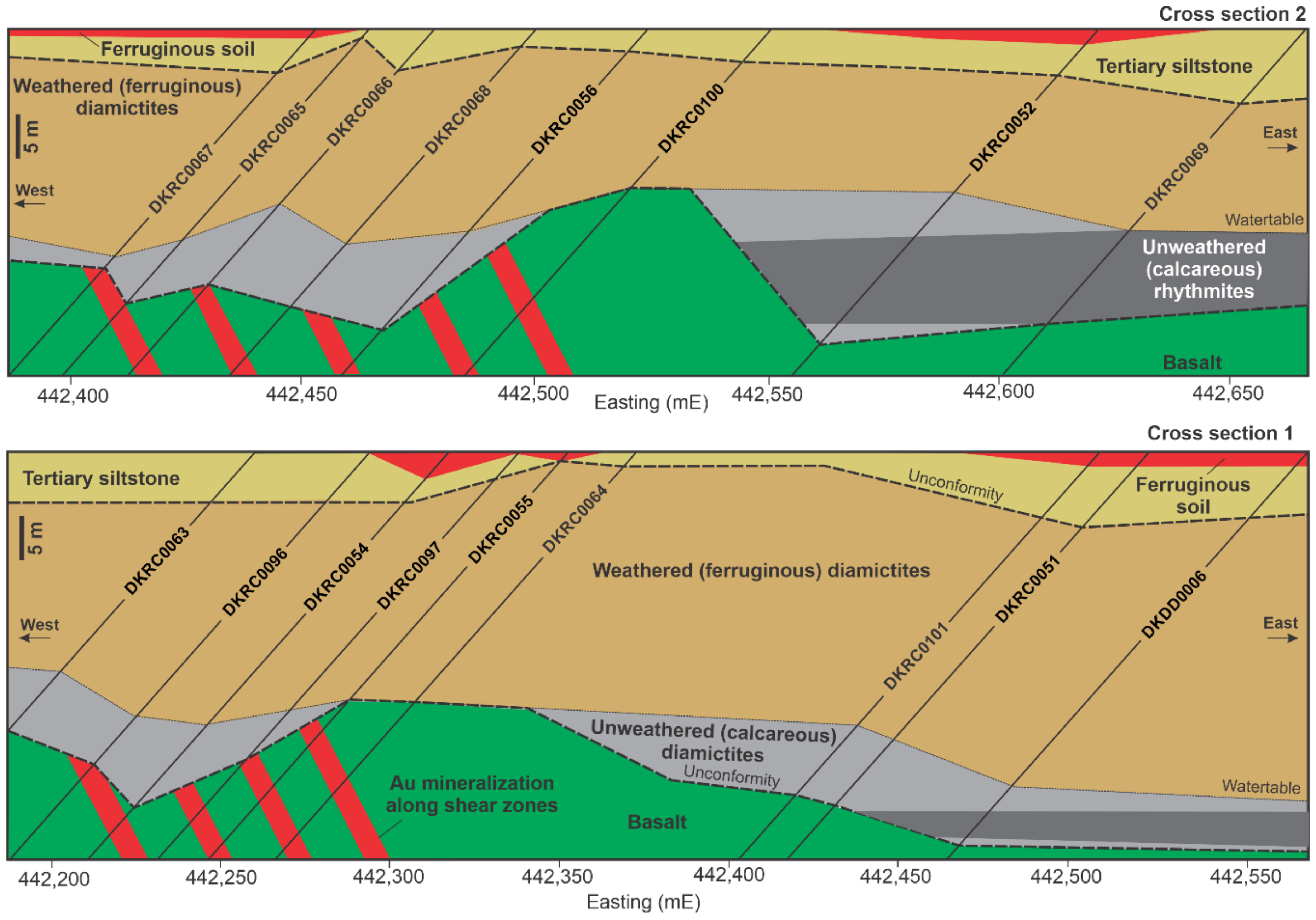
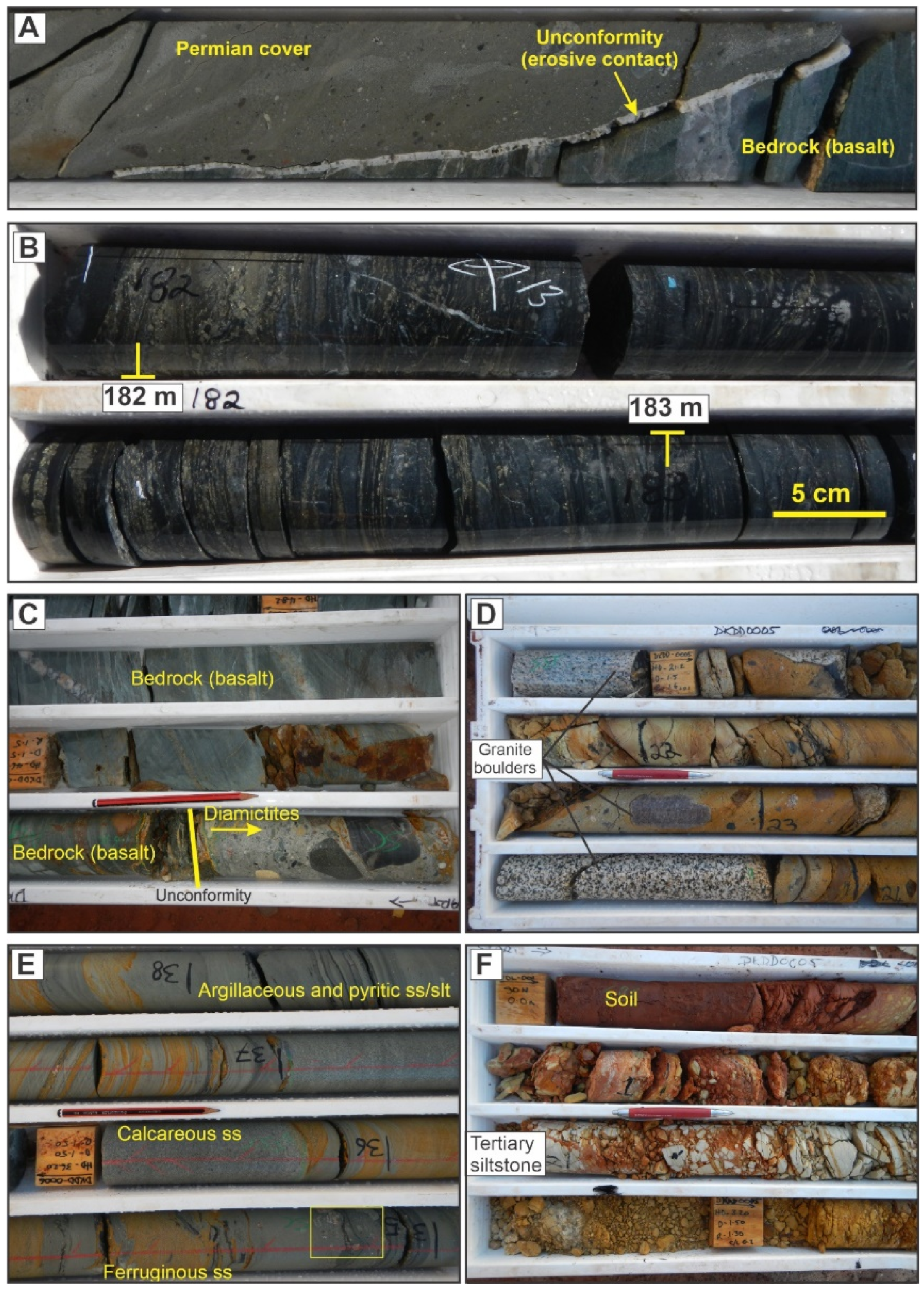
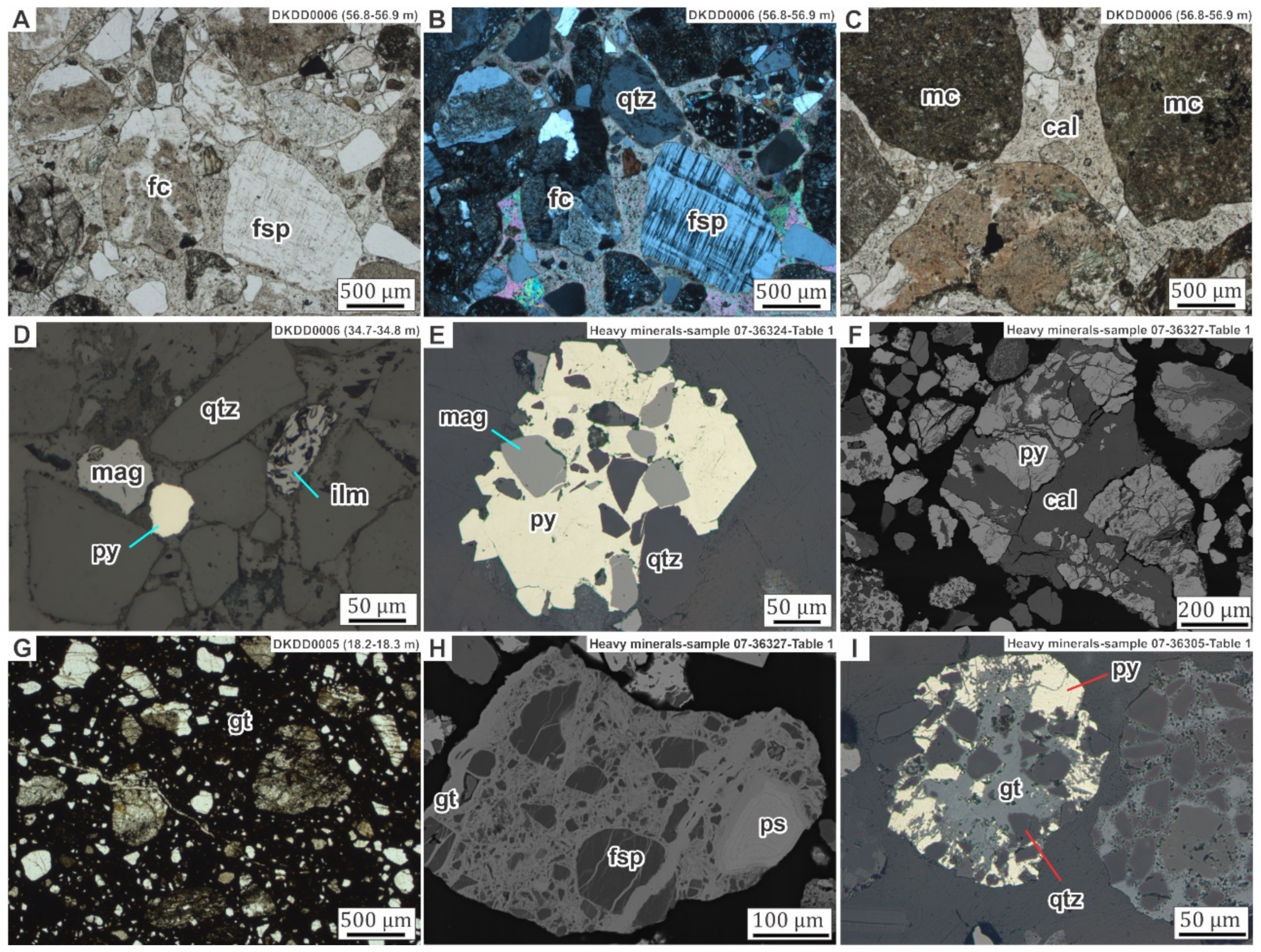
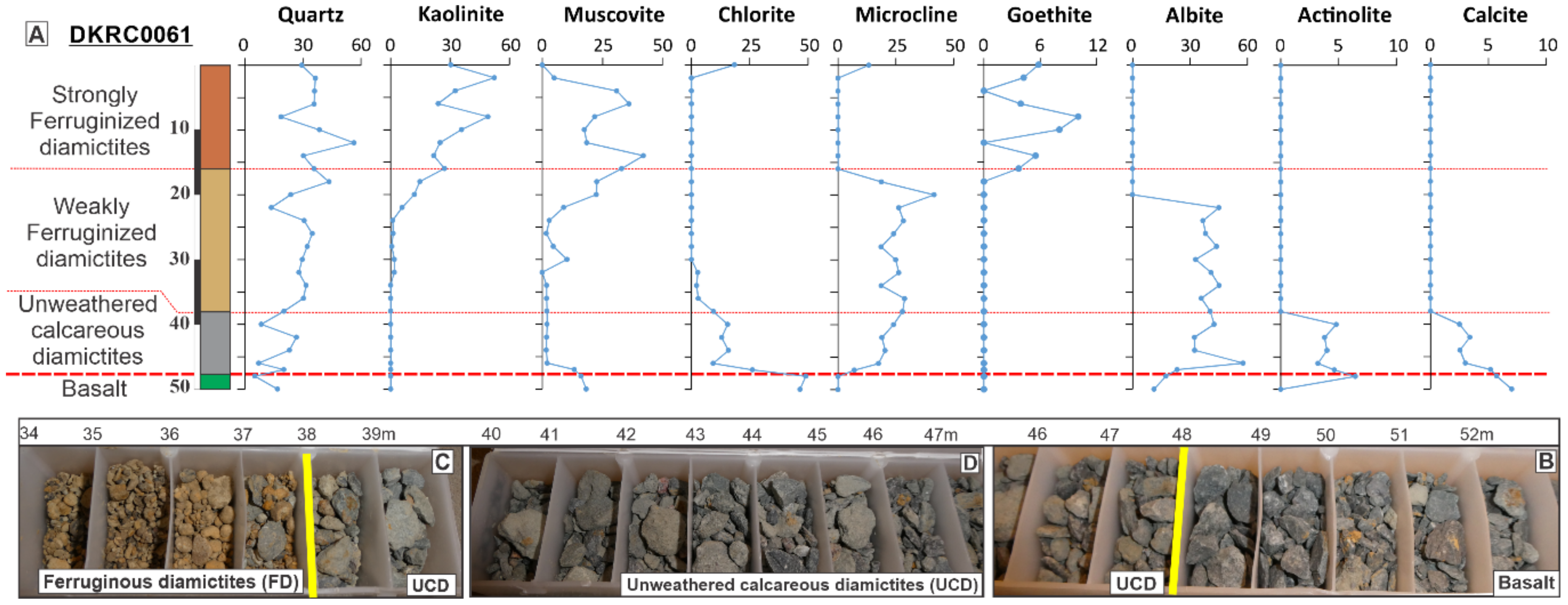
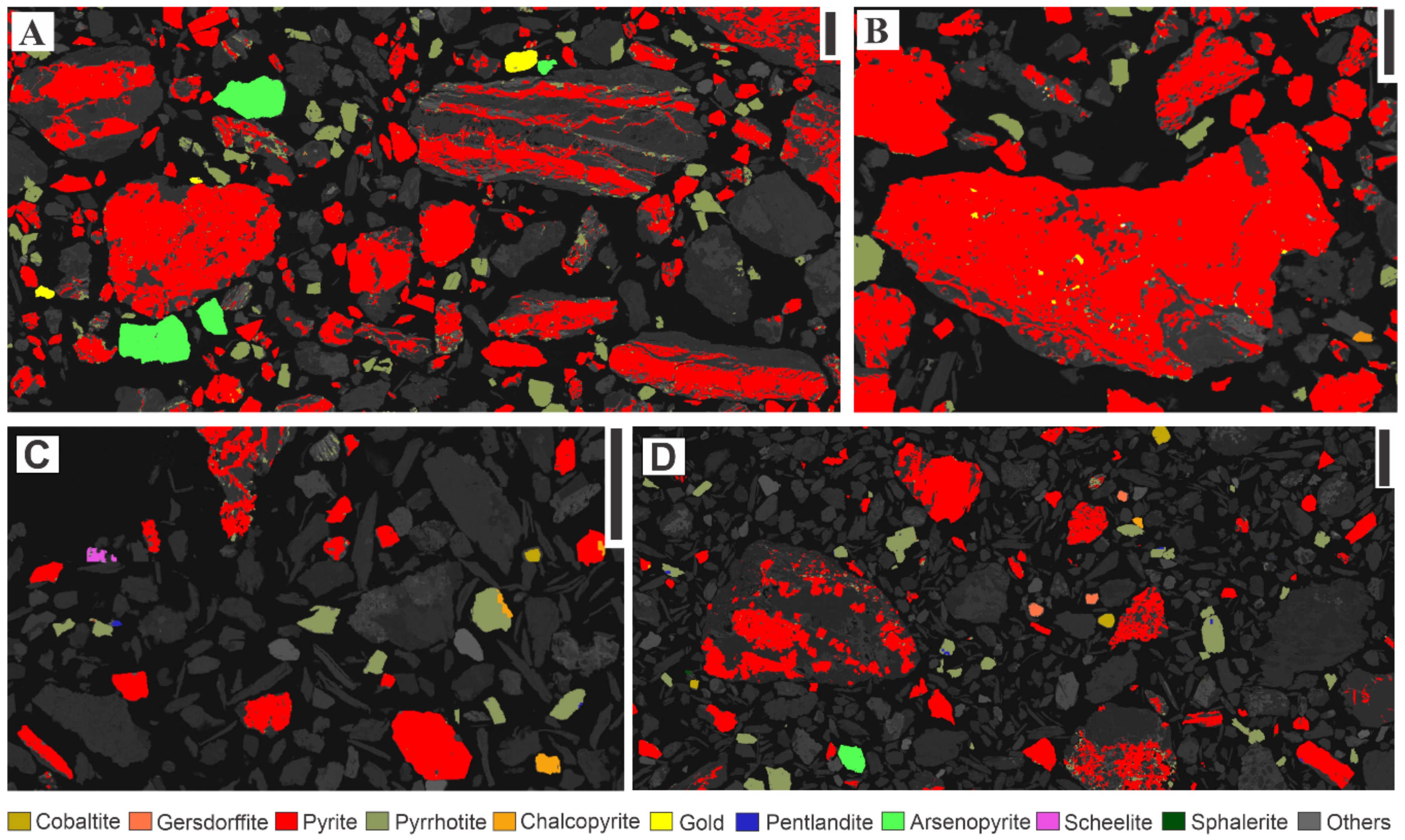
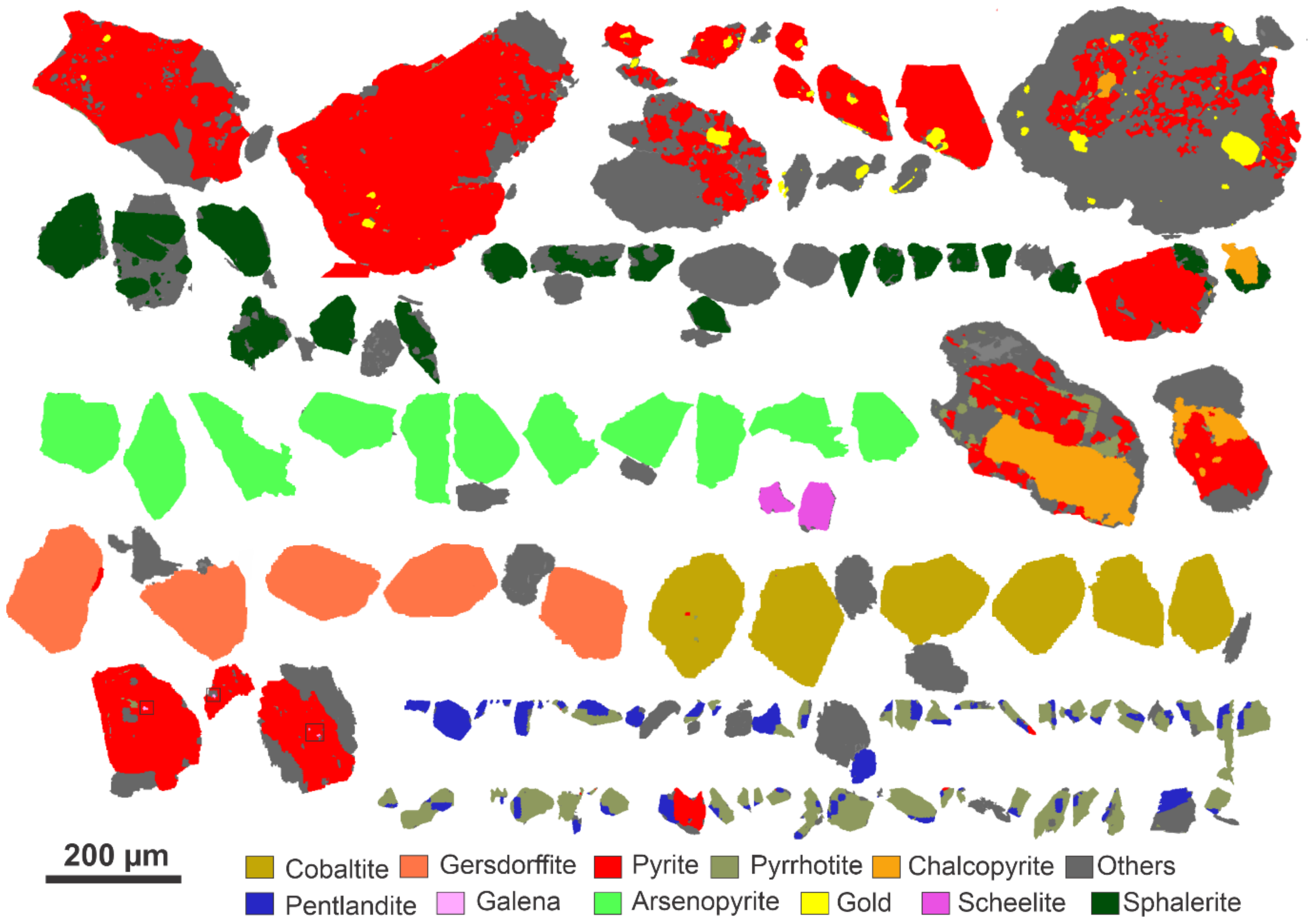
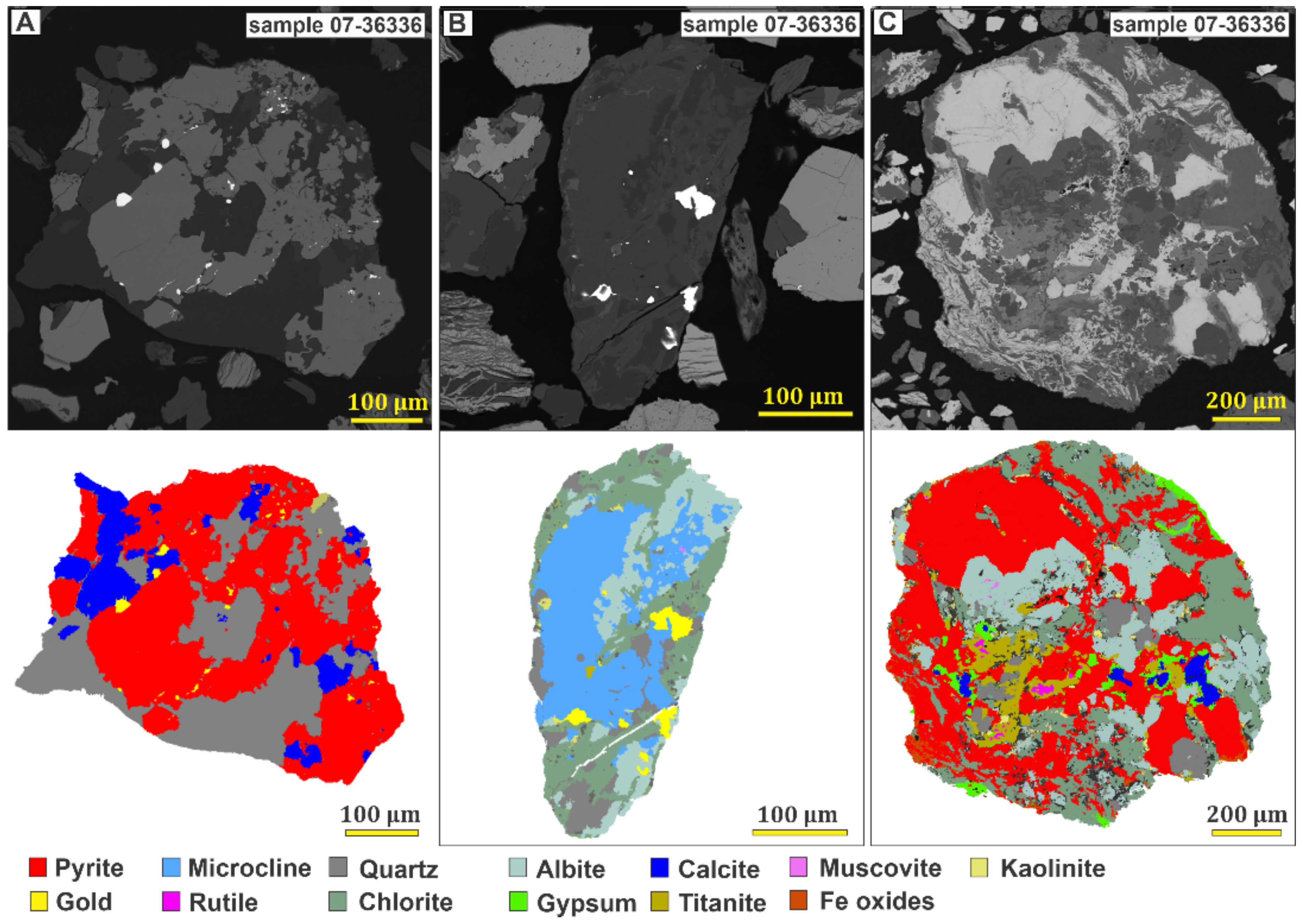

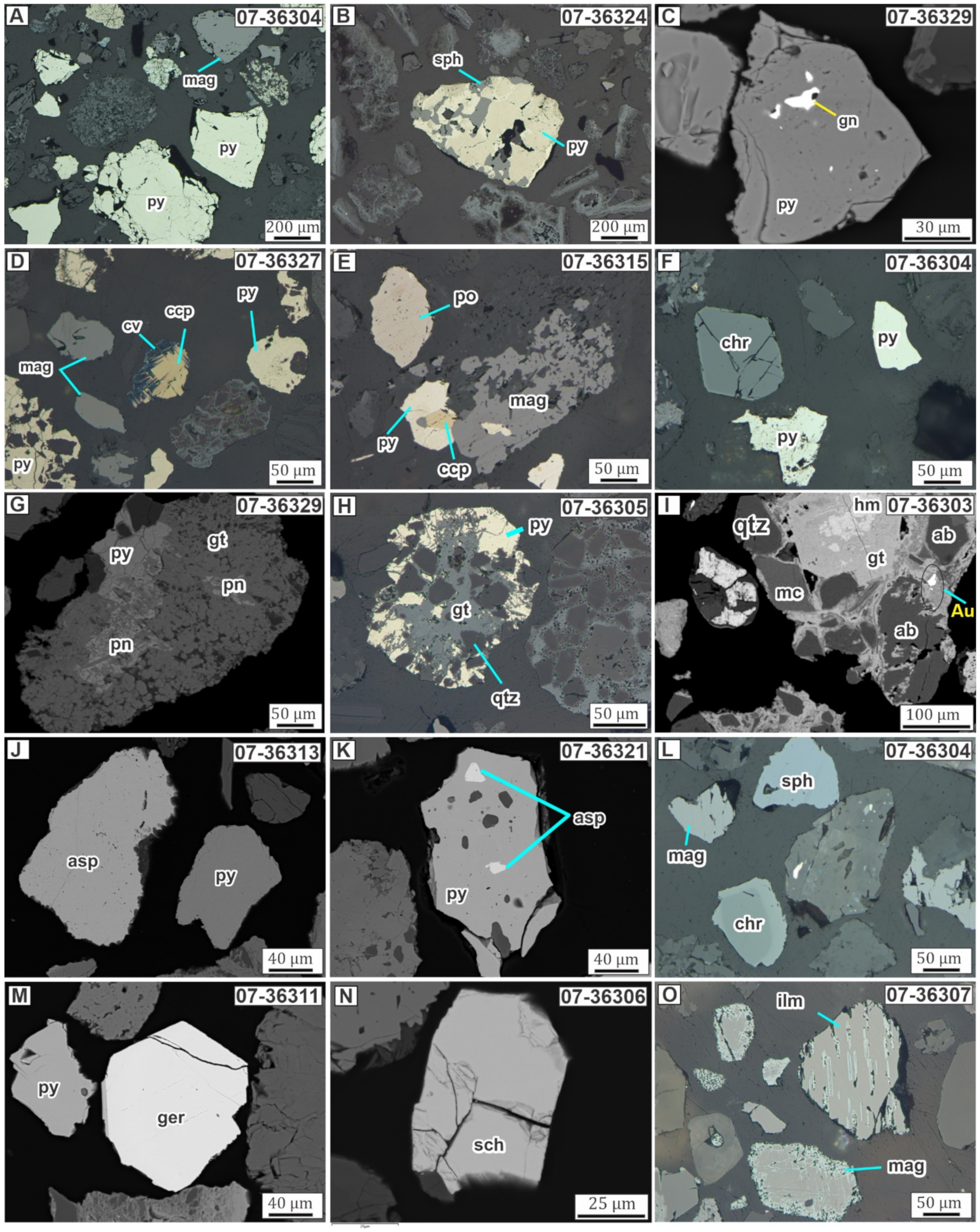

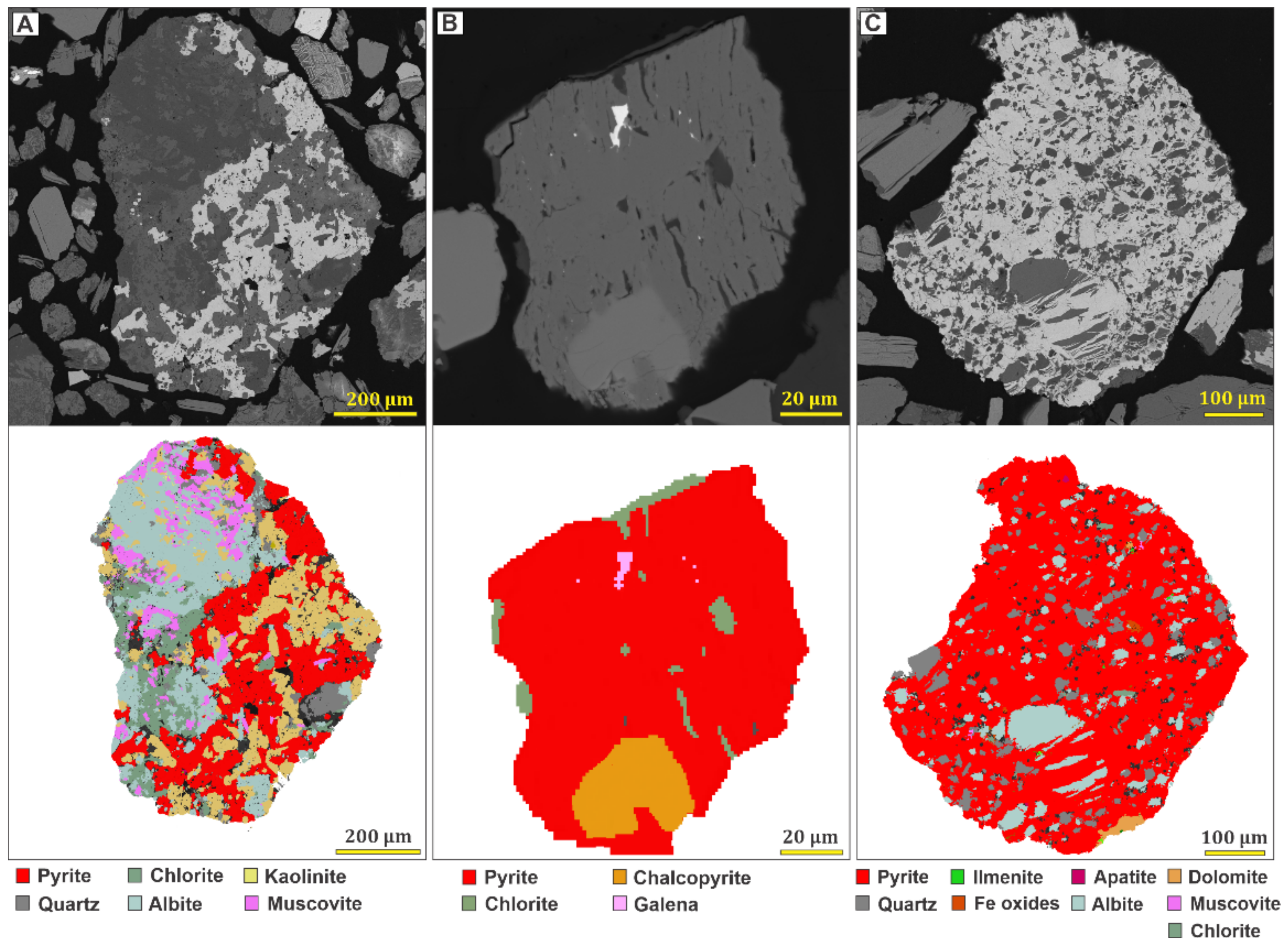
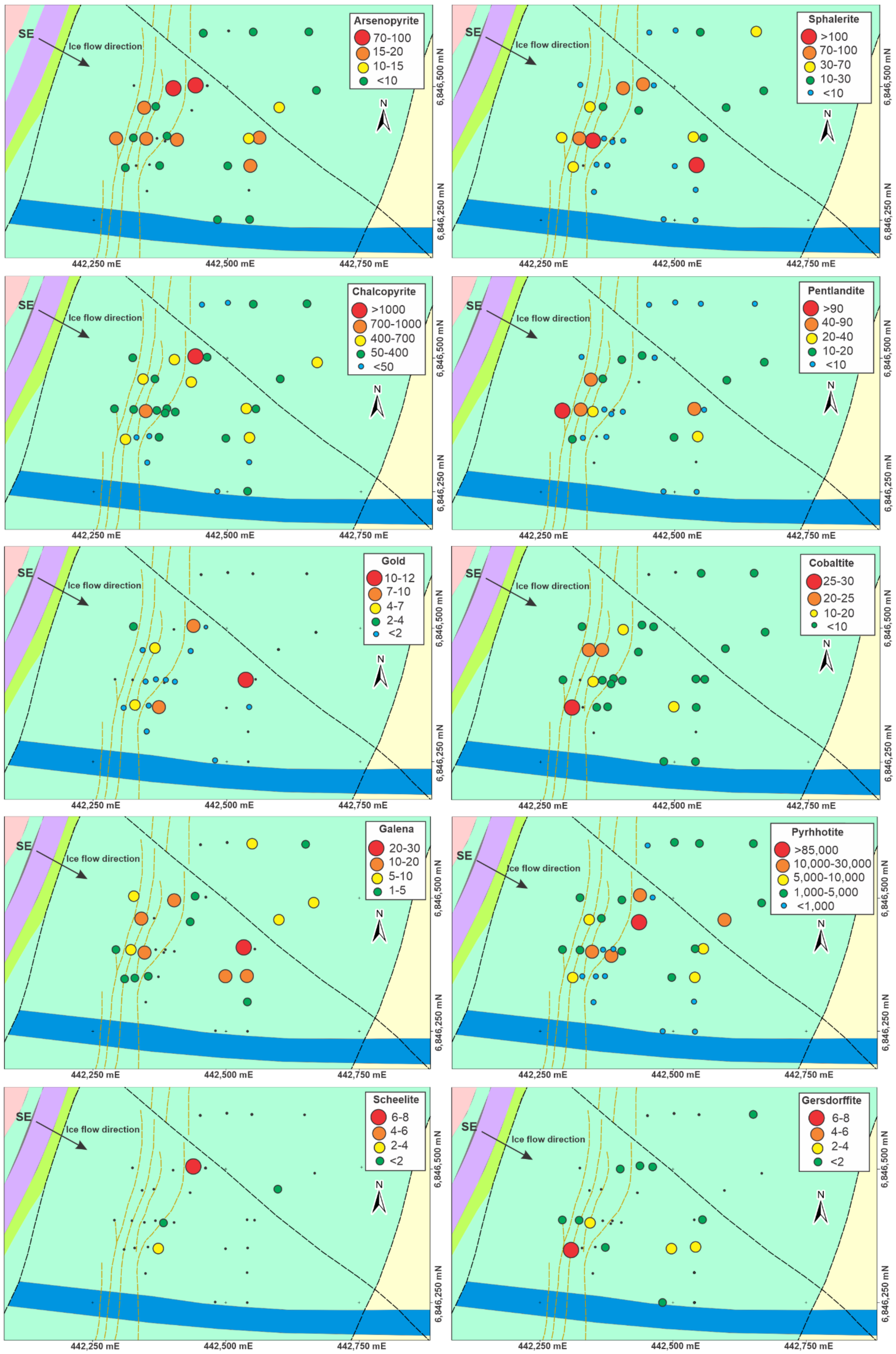
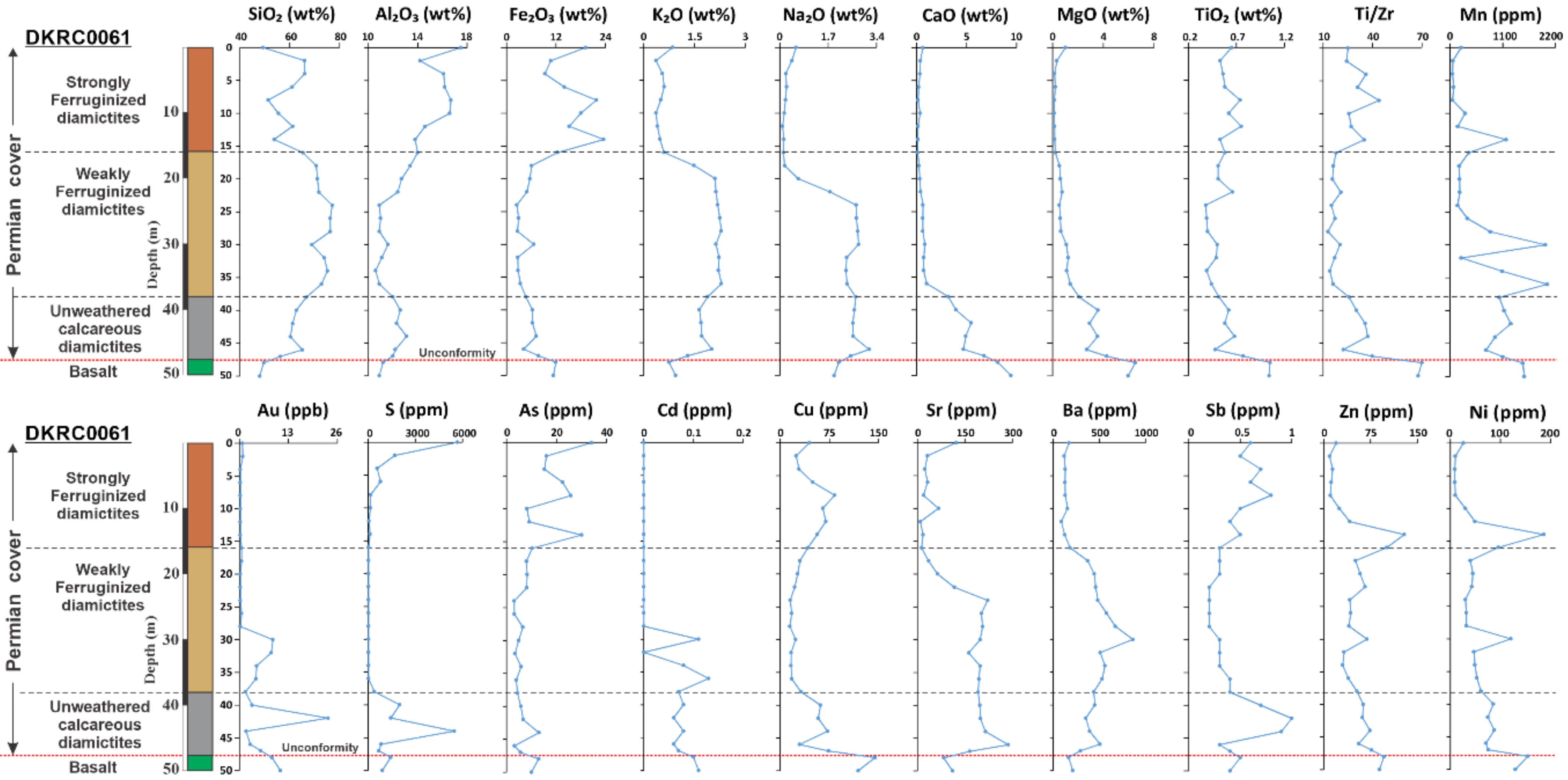




| Grain | Grain Size (in µm) of Heavy Minerals in the Ore Zone | Grain Size (in µm) of Heavy Minerals in the Permian Cover | ||||||||||
|---|---|---|---|---|---|---|---|---|---|---|---|---|
| Statistics | Nr. Samples | Nr. Grains | Min | Max | Avg | Std | Nr. Samples | Nr. Grains | Min | Max | Avg | Std |
| Pyrite | 3 | 334,217 | 1 | 983 | 21 | 41 | 33 | 536,371 | 1 | 830 | 18 | 31 |
| Arsenopyrite | 3 | 784 | 1 | 366 | 51 | 50 | 23 | 367 | 1 | 232 | 29 | 33 |
| Chalcopyrite | 3 | 4501 | 1 | 306 | 16 | 21 | 30 | 10,747 | 1 | 190 | 9 | 13 |
| Sphalerite | 3 | 514 | 1 | 179 | 14 | 19 | 27 | 1031 | 1 | 180 | 13 | 20 |
| Pyrrhotite | 3 | 257,800 | 1 | 714 | 6 | 460 | 33 | 233,628 | 1 | 306 | 4 | 6 |
| Gersdorffite | 3 | 401 | 1 | 102 | 24 | 23 | 13 | 29 | 1 | 57 | 9 | 13 |
| Gold | 2 | 1337 | 1 | 109 | 7 | 9 | 19 | 67 | 1 | 46 | 4 | 6 |
| Galena | 1 | 52 | 1 | 6 | 3 | 1 | 20 | 153 | 1 | 23 | 4 | 3 |
| Pentlandite | 2 | 664 | 1 | 60 | 8 | 6 | 27 | 685 | 1 | 89 | 6 | 7 |
| Scheelite | 2 | 6 | 2 | 86 | 37 | 34 | 4 | 13 | 1 | 83 | 32 | 31 |
| Cobaltite | 3 | 361 | 1 | 141 | 26 | 28 | 25 | 194 | 1 | 100 | 16 | 20 |
| Chalcocite | - | - | - | - | - | - | 21 | 754 | 1 | 88 | 6 | 8 |
| Covellite | - | - | - | - | - | - | 9 | 28 | 1 | 5 | 3 | 1 |
| Bornite | - | - | - | - | - | - | 26 | 1039 | 1 | 13 | 4 | 2 |
| Hole Number | DKRC0051 | Hole Number | DKRC0051 | ||||
|---|---|---|---|---|---|---|---|
| Depth (m) | 155–156 | 156–157 | 157–158 | Depth (m) | 155–156 | 156–157 | 157–158 |
| Sample Nr. | 07-36212 | 07-36213 | 07-36214 | Sample Nr. | 07-36212 | 07-36213 | 07-36214 |
| SiO2 (%) | 44.13 | 48.09 | 47.54 | Te (ppm) | 0.11 | 1.95 | 1.78 |
| Al2O3 (%) | 13.1 | 8.7 | 13 | V (ppm) | 222 | 165 | 266 |
| Fe2O3 (%) | 10.69 | 17.53 | 15.57 | Zr (ppm) | 46 | 48 | 69 |
| K2O (%) | 0.65 | 0.23 | 0.76 | Hf (ppm) | 1 | 1 | 2 |
| Na2O (%) | 1.67 | 1.06 | 2.21 | Nb (ppm) | 2 | 2 | 3 |
| MgO (%) | 6.96 | 5.26 | 6.63 | Ta (ppm) | <0.5 | <0.5 | <0.5 |
| CaO (%) | 10.29 | 10.73 | 6.46 | Th (ppm) | 0.3 | 0.4 | 0.3 |
| MnO (%) | 0.15 | 0.14 | 0.14 | U (ppm) | 0.07 | 0.13 | 0.1 |
| TiO2 (%) | 0.74 | 0.69 | 1.14 | Y (ppm) | 16 | 18 | 23 |
| P2O5 (%) | 0.04 | 0.06 | 0.12 | Ga (ppm) | 12.9 | 11.3 | 15.2 |
| LOI (%) | 11.58 | 7.51 | 6.4 | Sc (ppm) | 34 | 20 | 35 |
| Au (ppb) | 36.1 | 39,400 | 281,000 | Cs (ppm) | 0.9 | 0.5 | 0.8 |
| As (ppm) | 88.2 | 313 | 365 | Li (ppm) | 32.9 | 20.6 | 30.2 |
| S (%) | 0.2 | 5.4 | 4.33 | Rb (ppm) | 11.9 | 4 | 12.9 |
| Zn (ppm) | 106 | 282 | 125 | Sr (ppm) | 60.3 | 26.5 | 46.3 |
| Cu (ppm) | 105.2 | 401.8 | 349.7 | Tl (ppm) | 0.2 | 0.3 | 0.7 |
| Cr (ppm) | 271 | 140 | 189 | Ba (ppm) | 170 | 30 | 106 |
| Ag (ppm) | 0.05 | 2.6 | 18 | La (ppm) | 2.7 | 3.6 | 3.7 |
| Co (ppm) | 60.1 | 67.9 | 83.8 | Ce (ppm) | 7.1 | 9.2 | 10.2 |
| Ni (ppm) | 219 | 75 | 92 | Pr (ppm) | 1.12 | 1.4 | 1.64 |
| P (ppm) | 1 | 11 | 10 | Nd (ppm) | 5.1 | 6.4 | 7.9 |
| S (ppm) | 1 | 3 | 4 | Sm (ppm) | 1.8 | 2.1 | 2.8 |
| W (ppm) | 2 | 9 | 5 | Eu (ppm) | 0.7 | 0.97 | 1.1 |
| Be (ppm) | 0.7 | 0.7 | 0.6 | Gd (ppm) | 2.31 | 2.65 | 3.54 |
| Bi (ppm) | <0.1 | 0.4 | 0.4 | Tb (ppm) | 0.46 | 0.51 | 0.7 |
| Cd (ppm) | 0.11 | 0.23 | <0.05 | Dy (ppm) | 2.78 | 3.13 | 4.22 |
| Ge (ppm) | 0.53 | 0.82 | 0.95 | Ho (ppm) | 0.6 | 0.68 | 0.91 |
| Hg (ppm) | <0.05 | 0.06 | 0.61 | Er (ppm) | 1.81 | 2.09 | 2.72 |
| In (ppm) | 0.08 | 0.22 | 0.13 | Tm (ppm) | 0.26 | 0.3 | 0.42 |
| Mo (ppm) | 0.8 | 2.3 | 1.4 | Yb (ppm) | 1.7 | 1.9 | 2.6 |
| Sb (ppm) | 0.3 | 1.7 | 2.7 | Lu (ppm) | 0.27 | 0.3 | 0.39 |
| Se (ppm) | 0.77 | 4.48 | 3.64 | ||||
Publisher’s Note: MDPI stays neutral with regard to jurisdictional claims in published maps and institutional affiliations. |
© 2021 by the authors. Licensee MDPI, Basel, Switzerland. This article is an open access article distributed under the terms and conditions of the Creative Commons Attribution (CC BY) license (https://creativecommons.org/licenses/by/4.0/).
Share and Cite
Salama, W.; Verrall, M.; Culver, K.; Anand, R. Interface Sampling and Indicator Minerals for Detecting the Footprint of the Lancefield North Gold Deposit under the Permian Glacial Cover in Western Australia. Minerals 2021, 11, 1131. https://doi.org/10.3390/min11101131
Salama W, Verrall M, Culver K, Anand R. Interface Sampling and Indicator Minerals for Detecting the Footprint of the Lancefield North Gold Deposit under the Permian Glacial Cover in Western Australia. Minerals. 2021; 11(10):1131. https://doi.org/10.3390/min11101131
Chicago/Turabian StyleSalama, Walid, Michael Verrall, Kirsty Culver, and Ravi Anand. 2021. "Interface Sampling and Indicator Minerals for Detecting the Footprint of the Lancefield North Gold Deposit under the Permian Glacial Cover in Western Australia" Minerals 11, no. 10: 1131. https://doi.org/10.3390/min11101131
APA StyleSalama, W., Verrall, M., Culver, K., & Anand, R. (2021). Interface Sampling and Indicator Minerals for Detecting the Footprint of the Lancefield North Gold Deposit under the Permian Glacial Cover in Western Australia. Minerals, 11(10), 1131. https://doi.org/10.3390/min11101131







